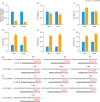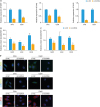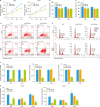INTRODUCTION
MATERIALS AND METHODS
1. miRNA-target prediction of XLOC_006390
2. Clinical samples
3. Cell culture and transfection
4. Cell Counting Kit-8 (CCK-8) assay
5. Flow cytometry analysis of cell apoptosis
6. Wound healing assay
7. Cell invasion assay
8. Immunofluorescence
9. RNA extraction and quantitative reverse transcription polymerase chain reaction (RT-PCR)
10. Western blot analysis
11. Statistical analysis
RESULTS
1. XLOC_006390 reversely regulated the expression of miR-331-3p and miR-338-3p
 | Fig. 1XLOC_006390 reversely regulates the expression of miR-331-3p and miR-338-3p. (A) The knockdown efficacy of XLOC_006390 in SiHa and Caski cells confirmed by RT-PCR analysis. (B-F) The expression of miR-125a-5p (B), miR-125b-5p (C), miR-331-3p (D), miR-338-3p (E), and miR-670-5p (F) detected by RT-PCR. (G, H) Potential binding sites for XLOC_006390 on miR-331-3p and miR-338-3p, respectively.RT-PCR, reverse transcription polymerase chain reaction; si-NC, small RNA without targeting genes.
*p<0.05 vs. the si-NC group.
|
2. miR-331-3p and miR-338-3p are significantly downregulated in cervical cancer
 | Fig. 2Expression of miR-331-3p and miR-338-3p was significantly downregulated in cervical cancer. (A, B) The expression level of miR-331-3p was significantly downregulated in the cervical cancer tissues compared to the corresponding adjacent normal tissues, and the expression of XLOC_006390 was reversely correlated to the expression of miR-331-3p. (C, D) The expression level of miR-338-3p was significantly downregulated in the cervical cancer tissues compared to the corresponding adjacent normal tissues, and the expression of XLOC_006390 was reversely correlated to the expression of miR-338-3p. (E, F) The expression level of miR-331-3p and miR-338-3p in HeLa, SiHa, Caski, C4-1, and C-33a cells detected by RT-PCR. (G) Over-expression of XLOC_006390 significantly downregulated the expression of both miR-331-3p and miR-338-3p in C4-1 cells.RT-PCR, reverse transcription polymerase chain reaction.
*p<0.05, †p<0.001 vs. the adjacent normal tissues, the HeLa group or Vector group.
|
3. Knockdown of XLOC_006390 downregulated the expression of miR-331-3p and miR-338-3p target genes
 | Fig. 3Knockdown of XLOC_006390 downregulated the expression of miR-331-3p and miR-338-3p target genes. (A) The expression of miR-331-3p target gene NRP2 and miR-338-3p target genes PKM2 and EYA2 in SiHa and Caski cells detected by RT-PCR. (B, C) Western blot analysis of miR-331-3p target gene NRP2 and miR-338-3p target genes PKM2 and EYA2 in SiHa (B) and Caski (C) cells. (D) Immunofluorescence study of the expressions of NRP2, PKM2, and EYA2 in the XLOC_006390 knockdown SiHa and Caski cells.si-NC, small RNA without targeting genes.
*p<0.05 vs. the si-NC group.
|
4. Upregulation of miR-331-3p and miR-338-3p inhibited cervical cancer cell migration and invasion and enhanced the cell apoptosis
 | Fig. 4Up-regulations of miR-331-3p and miR-338-3p inhibit cervical cancer cell migration and invasion and enhance the cell apoptosis. (A) The viability of the cells transfected by miR-331-3p and miR-338-3p mimics was detected by CCK-8. Cell invasion (B) and migration (C) were detected by Transwell assay and wound healing assay, respectively. The rate of apoptosis (D) and cell cycle (E) of both SiHa and Caski cells was determined by flow cytometry analysis. The expression level of mRNA (F) and protein (G) of the miR-331-3p and miR-338-3p target genes was detected by RT-PCR and western blot analysis.CCK-8, Cell Counting Kit-8; NC, negative control; RT-PCR, reverse transcription polymerase chain reaction.
*p<0.05 vs. the NC group.
|
5. XLOC_006390 facilitated cervical cancer tumorigenesis and metastasis by regulating miR-331-3p and miR-338-3p expression
 | Fig. 5XLOC_006390 facilitates cervical cancer tumorigenesis and metastasis by regulating of miR-331-3p. XLOC_006390 siRNA was co-transfected with miR-331-3p inhibitor. (A) The viability of the SiHa and Caski cells transfected by miR-331-3p inhibitor was detected by CCK-8. Cell invasion (B) and migration (C) capacities were detected by Transwell assay and wound healing assay, respectively. The rate of apoptosis (D) and cell cycle (E) of both SiHa and Caski cells was determined by flow cytometry analysis. The expression level of mRNA (F) and protein (G) of the miR-331-3p target gene was determined by RT-PCR and Western blot analysis.CCK-8, Cell Counting Kit-8; NC, negative control; RT-PCR, reverse transcription polymerase chain reaction.
*p<0.05 vs. the NC group.
|
 | Fig. 6XLOC_006390 facilitates cervical cancer tumorigenesis and metastasis by regulating of miR-338-3p. XLOC_006390 siRNA was co-transfected with miR-338-3p inhibitor. (A) The viability of the SiHa and Caski cells transfected by miR-338-3p inhibitor was detected by CCK-8. Cell invasion (B) and migration (C) capacities were detected by Transwell assay and wound healing assay, respectively. The rate of apoptosis (D) and cell cycle (E) of both SiHa and Caski cells was determined by flow cytometry analysis. The expression level mRNA (F) and protein (G) of the miR-338-3p target genes was determined by RT-PCR and western blot analysis.CCK-8, Cell Counting Kit-8; NC, negative control; RT-PCR, reverse transcription polymerase chain reaction.
*p<0.05 vs. the NC group.
|




 PDF
PDF Citation
Citation Print
Print



 XML Download
XML Download